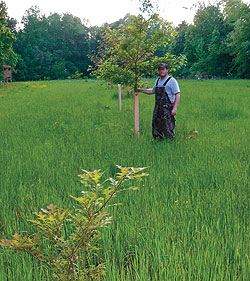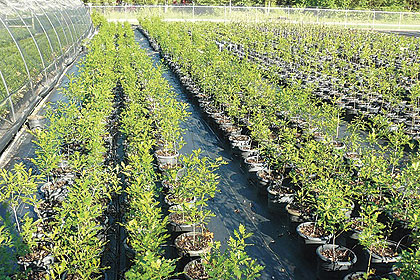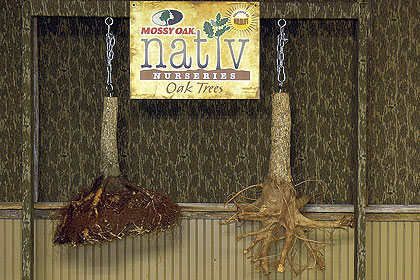November 04, 2010
By C.J. Winand
When you learn to grow mast trees bigger and faster, expect more acorns -- and more deer.
By C. J. Winand

Advertisement
|
Advertisement
Years ago, planting oaks and other mast-producing trees as part of a wildlife-management plan wasn't really a feasible option because it could take 20 years to realize the fruits of your labor.
That was then, and this is now.
Thanks to advancements in the science of growing trees, you now can plant oak trees and expect them to produce acorns within five to six years -- depending on latitude and soil conditions. New technology even has some oak seedlings producing acorns within three years. Yes, three years!
At the forefront of this cutting-edge technology is Mossy Oak Founder Toxey Haas and his Mossy Oak Nativ (no "e") Nurseries team. Toxey and the boys have been working with "elite" oak trees for a number of years, and their hybrid-oak research is helping landowners across the country enhance their Back 40s in just a few short years.
To understand, let's start with a few basics. Most trees are sold as a bare-root stock, meaning they have a taproot with a few hair-like feeders coming off the main root.
Dudley Phelps and coworkers at Nativ Nurseries highly recommend that you buy containerized oak saplings, but not those in pots that force the taproot to grow in a circle around the bottom of the pot. The saplings Phelps refers to have roots that are air or constriction pruned as a step in their growing system -- a trademark process called the Rapid Mast system.
Foresters know it takes time and lots of energy for a tree to establish its fundamental root system. Containerized Mossy Oak Elite seedlings can generate roots that look like they've been on steroids. Since the energy that would have gone into a root system now goes into stem growth, these seedlings mature quicker than regular seedlings. And with all the little feeder/finger roots from a sapling in a container absorbing nutrients, the Mossy Oak seedlings produce acorns at a much younger age than bare-root trees that are still growing roots. In time, these hybrid oak saplings will generate acorns on a two to four week basis every hunting season, pumping out pounds of acorns at basically no annual cost.
The Nativ Nurseries tree nerds (as they call themselves) also enhance seedling growth by slipping small-diameter tubes over the trunks of the trees. Condensation gathering inside the tubes helps water the seedlings. The tree nerds routinely grow 18-inch-tall, tubed seedlings to taller than six feet within one growing season. They even plant the tubed trees during the Mississippi summer heat, with one watering at planting.

Without a doubt, tree tubes work wonders to promote rapid growth and protect against deer damage. Inset: Last year, Mossy Oak Nativ Nurseries sorted through some 200,000 seedlings to select about 100 exceptional specimens, and this year they narrowed those to about 20, which will be further evaluated for future use as parent trees. |
Although four-foot tubes are the norm, five-foot tubes are even better, because an extra foot in tube length helps prevent deer from browsing young oak trees. Tubes also help in keeping small mammals from eating the bark off the saplings during the stressful winter months -- and bucks from rubbing their antlers on the trees.
Elimination of weeds and grass around the base of newly planted saplings is always good nursery practice. Spraying an herbicide or placing a tree mat around saplings ensures that the roots will absorb maximum moisture and nutrients.
Adding mulch around the trees is another way to eliminate weeds and grass and to maximize water and fertilizer intake. Dudley Phelps cautions against piling mulch too high around saplings. He believes a donut-shaped mulch pile that does not touch the tree stem is better. Too much mulch can attract ants and, if too wet, hinder roots from acquiring oxygen.
Some folks believe that fertilization of oak trees will result in better acorn production, but some researchers say fertilization of oaks is unwarranted because acorn drop is cyclic.
Although no research has proven that fertilization of oaks is beneficial, I still recommend fertilizing oak trees.
Ideally, it's best to wait until trees have become established before fertilizing because various critters are attracted to newly planted, fertilized trees. Waiting a month allows the roots to take hold and reduces damage by small animals. If you can't get back to your saplings within a month to fertilize them, bury fertilized tree spikes at least six inches from the saplings at planting. Slow-release fertilizer spikes won't burn the roots.
Maximizing Potential
How do you keep your oak trees healthy and consistently producing good acorn crops?

Which sapling do you think has a better chance of survival -- the bare-root tree (right) or the containerized sapling with an air-pruned root wad at left? |
One simple solution is to saw down undesirable trees that may be choking out your oaks -- a technique called releasing. The oak trees can now suck up all the available sunlight and root space. Releasing also works for soft-mast trees like apple, pear, persimmon, cherry, and mulberry,
Releasing your "keeper" oak trees draws in deer like a magnet. Better yet, all the trees you cut can be placed in a row to create a "living fencerow" that leads to and from your treestand. In woodlots with no such edge structure, the felling of one tree can be all that is needed to attract deer.
Timing Is Everything
It always amazes me how one or two mast trees dropping their acorns can change well-traveled deer trails. This especially applies if you plant and hunt different species of oaks around the acorn drop. By planting multiple types of oaks, you can actually pattern the time when they drop their acorns. White oaks drop their acorns first, followed by red oaks. By rotating your treestands among specific oak species, you can get the most mileage out of the acorn drop, which can be especially beneficial during years of poor mast production.
Not All Acorns Are Created Equal
White oak acorns average slightly higher in carbohydrates and lower i
n tannins (bitterness) than red oak acorns. They also drop within a briefer time period -- two to three weeks. Red oak acorns drop at a slower rate -- four to six weeks -- and contain more fats than white oak acorns. Acorn production relates largely to tree canopy.
Generally, large, less-crowded trees with more leaf area produce the biggest and best acorn crops.
Although many hunters don't realize it, some oak trees will consistently produce good acorn crops while others will not. Even oaks of the same species growing right next to each other can have slight differences, making one preferred by the deer. Recognizing the difference can help you fine-tune your hunting to an individual tree and specific time of year. And, yes, just like rut timing, the timing of the acorn drop can be the very basis for success!
C.J.'s Summary:
Oak trees, especially those in the white oak group, are very susceptible to hybridizing from other oaks. Red oaks hybridize, too, but don't seem to obtain the famed hybrid vigor as often as white oaks. Cross-pollination leads to faster growth and greater acorn production at a younger age, which has spurred a whole new field within the tree nursery business.
Some of the new types of hybrid oak trees include Bodacious bur or Schuett's oak (cross between bur oak and swamp white oak); Sergeant oak (English and white oak); Compton oak (overcup and live oak); and, my personal favorite, Bimundors oak (English and white oak).
Believe it or not, Toxey Haas has been responsible for at least half of Nativ Nurseries' hybrid oaks. He collects gallons of acorns every year. Toxey regularly drops off family and friends at their deer stands and then goes to his spot only to walk around and collect more acorns.
For more information on Mossy Oak's Nativ Nurseries and to purchase hybrid oaks and other trees, call (662) 494-4326 or visit www.nativnurseries.com.
